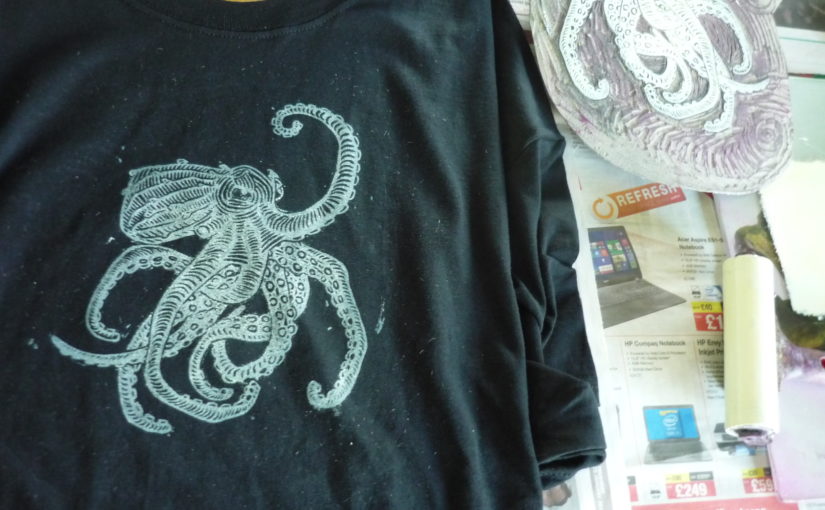I’ve been making lino cuts on and off for twelve years now – it’s a very satisfying medium, as the results of your drawing, cutting and inking all come out in one big reveal. Here’s some tips on what I’ve found are the most effective ways to turn out good prints at home.
Lots of people swear by heating your lino – maybe the average lino is a little harder than my supply, but if you store it in a warm room, or have a table set up to catch a sunbeam, you should be good to go. If it’s cold inside and the blade is absolutely refusing to dig in, then yes, absolutely, use your oven on the lowest setting. Give it five minutes, and see how you get on. If it gets too warm, it will start tearing instead of cutting and your details will just crumble. Use short, careful strokes, like you’re slowly writing a word, instead of longer ones like you’re using a knife, and you’ll be much less likely to slip. Always make sure your fingers aren’t in front of the blade!
A toughened glass chopping board is my surface of choice for rolling out ink.
Your printing material will make a big difference as to how your prints will come out (I am writing about oil-based inks here). Cotton t-shirts are by far the easiest surface to ink onto, as their soft, slightly fuzzy surface grips the ink amazingly well. As a rule, softer papers like newsprint or printer paper take ink much more dependably than artist’s papers, which tend to slide around a heartbreaking amount when hand-pressing. My advice for paper prints is to try and find a local college or print studio that has a relief press and will let you use it, as it is just about impossible to get clean prints on thick paper if all you have to press with is a big spoon. That same spoon, or a big book, are all you need for printing on fabric though – for the most consistent results, I use a wool felt mat as a base, with a newspaper cover, as this lets the lino and the printing surface join together evenly. Some people advise glueing your lino to a plywood sheet, but unless the sheet and your table are exactly flat you’ll get spots that just won’t print evenly.
Clean-up is important. For oil-based inks, stay away from white spirit – the best solvent is cooking oil. Use cotton rags, because paper towels mush up and fill in all your glorious fine details you slaved over. Have some extra newspaper on hand, and make some quick newspaper prints to soak up the extra ink – wipe off your lino and get the excess off your roller too, it means there’s much less scrubbing to do.
Lastly: drying. If you have a sunny, windless day, go right ahead and hang your prints outside to speed things up. Otherwise, leave them in the warmest, most out-of-the-way spot you can find – if you’re in a mad hurry, some very careful ovening will do the trick.
